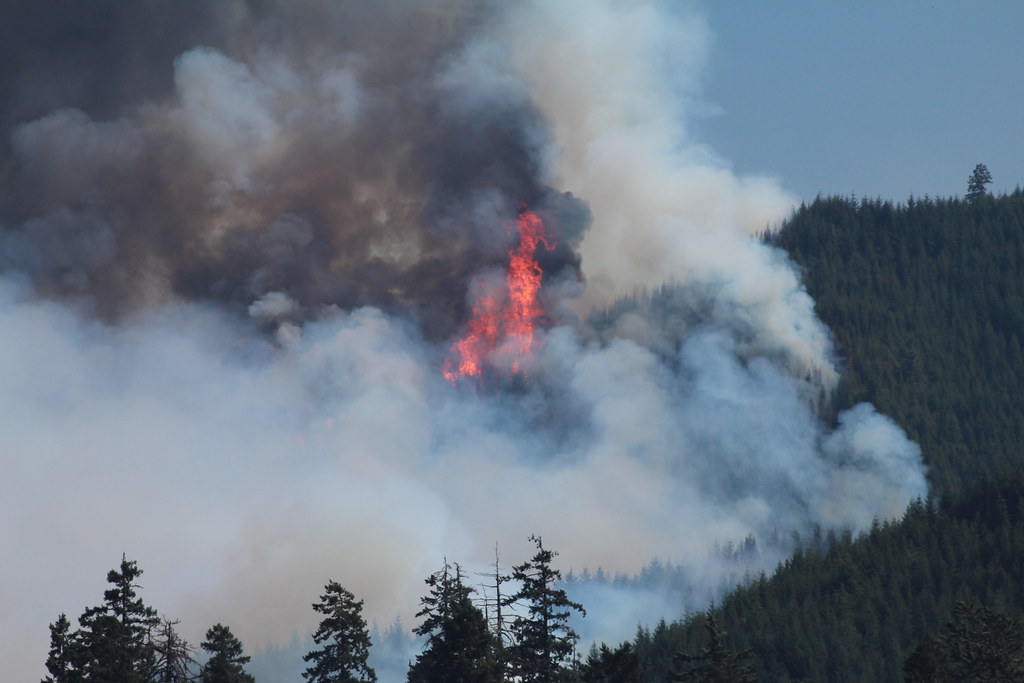For tens of thousands of years, fire has graced the forests that now make up the Mt. Hood National Forest. From controlled Indigenous burning to large blazes spanning hundreds of thousands of acres, fire plays an essential role in maintaining ecosystem health.
Over the past one hundred years, the character of the forests has been vastly changed by logging, grazing, development, and fire exclusion. Bark advocates for fire policy that recognizes the important ecological role of fire and moves away from full suppression of every ignition, while at the same time recognizing the need to prioritize increased community preparedness and resiliency.
Forest Fire Lightning Round: Questions & Answers
Q1: Does fire destroy forests?
No! Fire ecologists know that fire is an essential part of most forest types and many species actually depend on fire for survival. According to Dr. Dominick DellaSala, co-editor of The Ecological Importance of Mixed-Severity Fires: Nature’s Phoenix, there are countless ecosystem benefits of large and severe fires because “the post-fire landscapes created by these fires are not ecological disasters, rather they are rare ecosystems that have a unique role to play in the long-term health of our forests.”
Q2: Are fires burning larger and hotter because of a hundred years of fire suppression?
The intensity of a fire is based both on the fire cycle of the area and the specifics of each particular fire – with weather being the most important factor influencing fire behavior. While a century of fire suppression has left specific ecosystems in conditions that are outside their natural range, this does not automatically mean a fire will burn more intensely. Fire ecologist Chad Hanson found, “contrary to popular misconception, areas that have missed the greatest number of natural fire cycles, due to fire suppression, are burning mostly at low-and moderate-intensity and are not burning more intensely than areas that have missed fewer fire cycles.”
Q3: Is climate change resulting in larger, “unnatural” fires?
It’s not that simple. The increased length and severity of drought associated with climate change is making some forests drier, which can make fire season longer. However, these fires aren’t “unprecedented”. In the Pacific NW, large forest fires are not unnatural and, historically, large fires were more common than most people realize. There was a drought from 1920-35, in which very large fires burned across the West. From 1935 to 1985, however, there was a cooler, wetter period in which we developed a cultural expectation that humans could control fire behavior. As the climate again warms and the drought has no indication of stopping, we need to rethink the “full suppression” approach adopted during a wetter time.
Q4: Because of climate change, shouldn’t fires be suppressed so that they don’t add additional carbon into the atmosphere?
Nope. When forests burn, the vast majority of the carbon remains in trunks, roots and soil. Even the most severe fires release only about 5% of the forest’s carbon into the atmosphere. The remaining carbon is slowly returned to the soil or released through decomposition in a natural cycle that replenishes the forest with nutrients and feeds new growth. In contrast, logging releases over 60% of the carbon in cut forests and diminishes their ability to sequester carbon for many years. In addition, researchers recently found that the highest carbon sequestration levels were in forests that had previously experienced considerable occurrence of high-intensity fire.
Q5: Why is the Forest Service spending so much money fighting fire?
As observed by OSU professor John Bailey, “right now we’re spending billions of dollars to prevent something that is going to happen sooner or later, whether we try to stop it or not, and something that can assist us in sound land management.” Why is this the case? Because the U.S. Forest Service has a policy of suppressing all fire ignitions outside of designated “wilderness”, coupled with a blank check from the Federal Treasury for firefighting. These two policies combine to create a reactive system that wastes millions of dollars, and sometimes firefighter lives, to fight fires that may have significant ecological benefit.
Q6: How should the government plan for forest fire management on public lands?
We need to learn to co-exist with fire! For individuals and communities who live in the “wildland urban interface”, fire is a real threat to home and livelihood. This could be proactively addressed by making homes and towns more firewise. The federal government could help support these efforts with technical and financial support. The Forest Service could also end its outdated full suppression policy and use forest fire as a management tool to restore fire-dependent ecosystems. This, coupled with fixing the broken “blank-check” approach to fighting fires on National Forests, would result in a much more realistic approach to forest fire management.
Q7: Are burned forests still healthy?
Yes! Post-fire landscapes are unique, fascinating, and incredibly biodiverse. Ornithologist Richard Hutto, in his article The Beauty of a Burned Forest, states “Burned forest habitat is one of nature’s best-kept secrets because the public really hasn’t been told about the magical transformation a forest undergoes after severe fire.“
As an organization committed to the protection of Mt. Hood’s forests, Bark advocates for land management practices that recognize forest fire as a positive agent of ecological change. Fire policy should focus on increasing community preparedness and resiliency, not backcountry logging and full suppression.

Associated Files